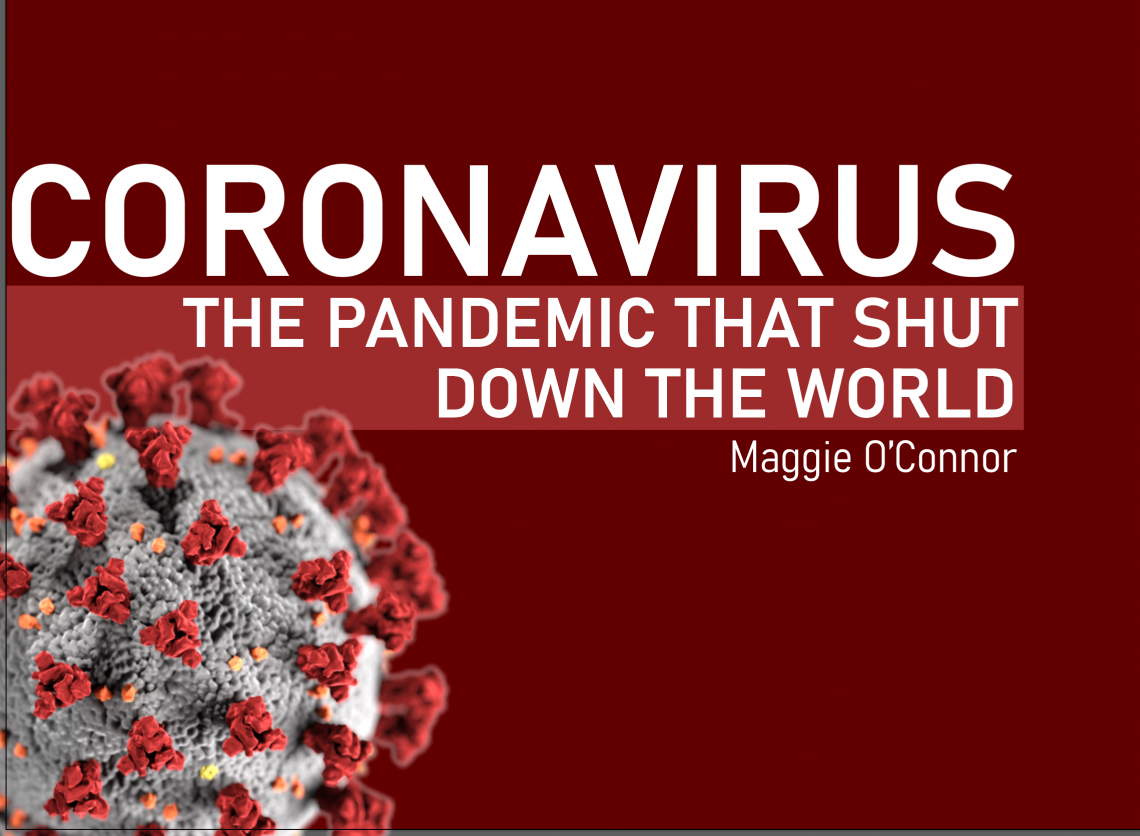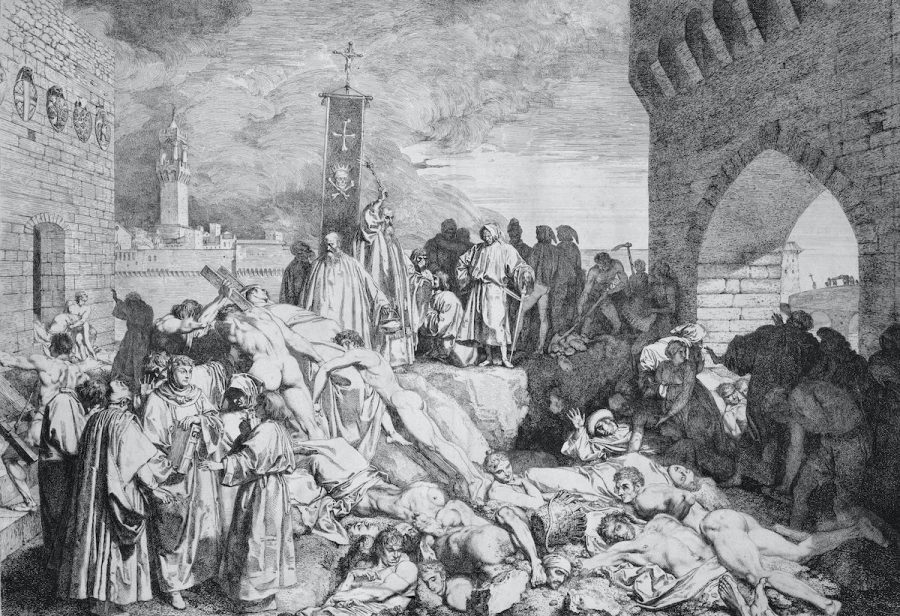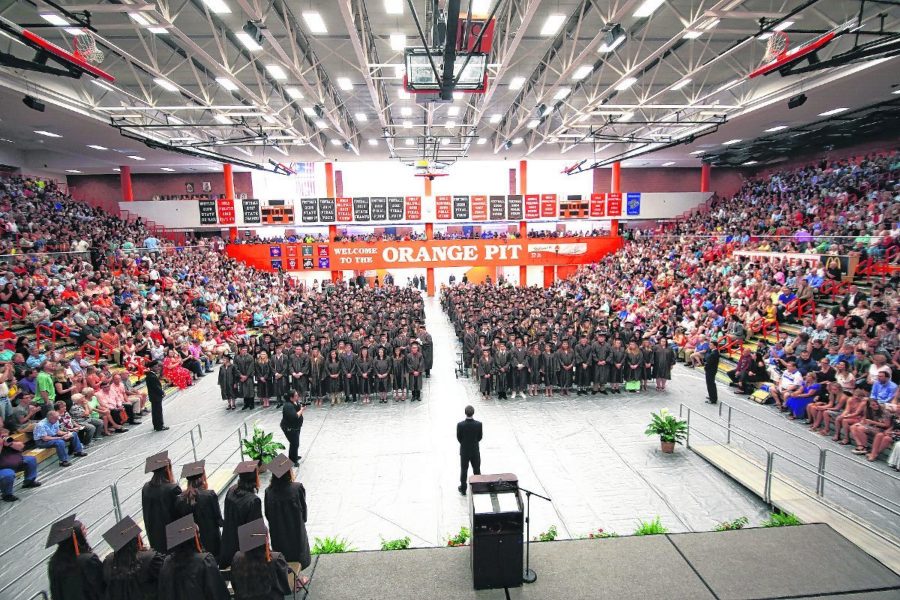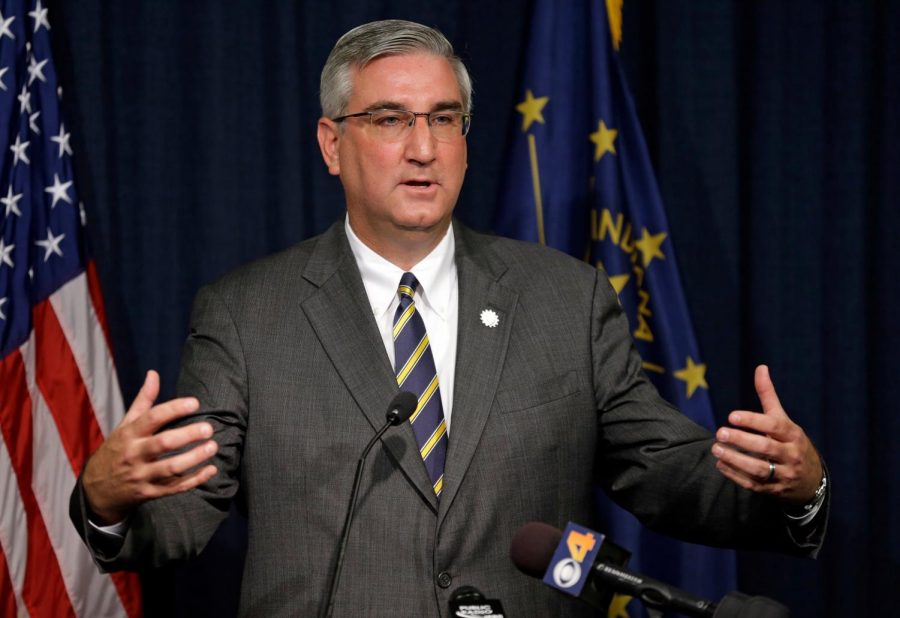Coronavirus: The Pandemic That Shut Down the World
May 19, 2020
The impact of the COVID-19 pandemic is catastrophic. Worldwide, nations are facing economic turmoil and health crises. While these effects are all over the news, the local effect is just as critical, which is the focus of this story. Also included is the history of pandemics, and how that has affected the novel Coronavirus outbreak.
The History of Pandemics
Since early March 2020, the coronavirus has been dominating world news and taking the lives of thousands. The coronavirus, scientifically known as COVID-19, is not necessarily a new virus. Human coronaviruses have been around since the 1960s, when the B814 virus was identified as one. Since then, coronaviruses have been known to spread like the common cold, and present similar symptoms to an average, healthy human. Those with underlying conditions such as asthma, chronic lung disease, and individuals with weak immune systems are at higher risk for complications. The COVID-19 virus has presented the same symptoms as past coronaviruses, with the same groups at higher risk for developing serious complications. While not much is known about the origin of COVID-19 yet, it’s rapid spread began around Nov. 2019 in Wuhan, China, and was kept in control around the area until it’s rapid spread was unpreventable.
Similar to the COVID-19 virus, diseases have taken a toll on Earth since the Bubonic Plague epidemic of Europe in the mid-1300s. The Bubonic Plague was considered an epidemic because it only affected one region of the world (Europe). The COVID-19 outbreak is a pandemic because it is a worldwide issue. The Bubonic Plague is also where the idea of quarantining originated from. When infected ships began to arrive in Venice, Italy during the Bubonic Plague outbreak, the ships were required to stay docked at the ports for 40 days before returning to sea. American quarantining began when the yellow fever began to spread across the United States in 1878. The legalization of quarantining led to a long history of its use when contagious diseases were found present in the United States. The most recent pandemic to affect Americans is the 2009 H1N1 (Swine Flu) outbreak. Just like COVID-19, H1N1 was declared a national emergency. However, the H1N1 outbreak was not nearly as catastrophic as the COVID-19 outbreak has been so far.
The extensive damage COVID-19 has done to the economy, the job market, and the health of American citizens has brought many to take extreme actions. Grocery stores across the nation are wiped out of essentials such as toilet paper, hand sanitizer, and face coverings. The average grocery store has checkout lines 10 carts deep, resulting in stores lowering their maximum occupancies to help thin out the crowds. Individuals that are buying items like toilet paper and Clorox wipes in bulk often do this for psychological reasons. Pandemics and uncertainty can cause anxiety, and therefore people feel the need to purchase as many essentials as they can in case they will not be able to get them again. The more people that follow this type of thinking, the more they are actually contributing to the problem. Watching others stock up on milk may compel someone else to do the same, and by the end of the day that store is out of milk. This is the case with hundreds of items across the globe. Even though it may seem like there is no toilet paper to be found, the companies that make it have not stopped production. Rest assured, there will be more toilet paper to be had soon enough.
Similar to the psychological effects that the COVID-19 outbreak has had on shoppers, this pandemic also has the potential to cause racist tensions to boil over. There is a lot of speculation as to how the virus began, but there is no question that its birthplace is China. It is very easy for racial prejudices to arise when something that has taken so many lives came from a specific place or culture. Even though this virus originated in China, that does not mean that they created the deadly disease on purpose. Although it was not as severe, the world had thoughts similar to these about Americans after the H1N1 virus began to spread. Like some have called COVID-19 the “Chinese virus,” other nationalities called H1N1 the “American Flu.” While it can be very easy to place blame on other nations for a crisis as extensive as the COVID-19 outbreak, it should not be an excuse for racism and prejudice.
Effect on Students
While the COVID-19 pandemic has had many nationwide effects, the local issues are just as detrimental to students. Since Gov. Holcomb announced that schools must remain closed for the remainder of the academic year, many special events have been cancelled. Traditional graduation, prom, and all sporting events for the rest of the year have been called off due to the school closures. This year’s seniors will be honored through a virtual graduation, for which more information will be announced soon. These cancellations and more have taken a toll on many students across BCSC, including many seniors who will miss out on lots of high school memories that they would have ordinarily been able to make.
East senior Savannah Downey was looking forward to many things that are now not going to happen, but she understands that it is for the safety of everyone in the district. Regarding graduation Downey says “As great as it would be to get to walk the graduation stage, I understand why it has to be done this way.” The COVID-19 pandemic has left many things to chance, but BCSC has chosen to make a definitive decision about graduation early on. “We don’t really know how long this situation is going to last, so postponing graduation would be pointless. I know I wouldn’t be able to come home from college if graduation got pushed to sometime in the fall. I think they are handling the situation as best they can” Downey says. Similar to Downey, senior Ashley Novreske agrees that virtual graduation will be beneficial. “I think virtual graduation is the best option given the current situation. I believe that the diploma is more valuable than walking across the stage, we earned the diploma” Novreske says.
As well as graduation, seniors like Downey will be missing out on their last high school prom. “I was disappointed when prom got cancelled. I had a lot of fun last year and was excited to go again” Downey explains, “plus, I already purchased my prom dress, which wouldn’t be that big of a deal except the dress was non refundable.” Lots of juniors and seniors are in this same situation. Prom dresses are not cheap, and buying a non refundable dress as a senior does not leave students with many options for getting their money back.
High school was more than just prom and graduation for seniors like Downey and Novreske. “I was looking forward to more lunches with my friends before we all part ways,” Novreske explains, “but my favorite memory from East was the first day back to school for me after I had surgery. I was on crutches and there was a fire drill… just my luck. Mr. Vogel carried me down the stairs.” But for Downey, there were too many highlights from her time at East to choose from. “I don’t know if I have one specific favorite memory. There have been so many great moments at sporting events, dances, club events, and even in my classes” Downey says. The almost four years the class of 2020 got to spend were packed full of good times.
While the COVID-19 school cancellations has had many downsides, there are always positives to a situation like this, no matter how small. “I think one positive for me is sleep,” Downey says. Senior year can be hectic, and it is not every year that students get the whole fourth quarter off. “During the school year my schedule is so packed with school, clubs, activities, and having multiple jobs, so I never get much sleep,” Downey explains. The COVID-19 pandemic has given students across America to catch up on all the sleep they miss during the school year. Novreske agrees, as she was ready for her high school career to come to a close. “I’m happy school was cancelled for the rest of the year… I’m ready for the next chapter in my life.”
Another challenge that school cancellations present is how to navigate online learning. BCSC schools have chosen to conduct E-Learning Tuesdays, Wednesdays, and Thursdays until May 21. E-learning can have its pros and cons, but it is all about finding the balance. Junior Jacob Pierce agrees. “There are negatives and positives,’” Pierce explains, “sleeping in and being able to work at your own leisure is certainly a plus.” Having more time to sleep and working at your own pace seems to be a common plus-side among students. Even though staying home can be beneficial, not having that social lifestyle that school gives students can be a challenge. “I miss the social interactions every day with friends especially, but also the inside jokes in class with teachers” Pierce says. E-learning also presents the challenge of managing a different type of workload. The amount of work received every day can seem overwhelming if students get started later or are in lots of high-level classes. “It’s really a mixed bag, some teachers have recognized that students aren’t as motivated to do work as they would be at school, and have matched that. Others have gone a little overboard at times, but once students and teachers made the proper adjustments, it hasn’t been too bad” Pierce explains. E-learning is all about student-teacher communication. Being able to access teachers so easily has made e-learning and the COVID-19 adjustments seem more manageable.
Politics and the Economy
A crisis as extensive and damaging as the COVID-19 pandemic should never be taken lightly, especially when it can and will directly affect the economy. The financial details surrounding the COVID-19 pandemic are some of the most important effects that the crisis is having on everyday lives. Hundreds of thousands of jobs have been eliminated or furloughed, all while unemployment numbers have skyrocketed in the US. Solutions to these various problems, along with reopening the economy, are all being made as we go by President Trump and the White House Coronavirus Task Force, led by Vice President Mike Pence. All of the various actions taken since the COVID-19 crisis was declared a national emergency have rippled not only local change, but national change to our daily lives.
The concerns surrounding the job market are high, since so many Americans have already lost their jobs due to this pandemic. The statewide stay-at-home orders issued by most states’ governors have resulted in thousands of business closures. For instance, the Walt Disney Company has closed all of its resorts, theme parks, cruise lines, and stores indefinitely, resulting in 43,000 jobs being furloughed. Another company that has had major downsizing is Macy’s department stores, which furloughed 125,000 employees as of March 30. These companies, like many other retail stores and theme parks, are legally obligated to be closed. All of the employees that would normally be doing on-site work like landscaping, construction, or stocking cannot work until these locations are allowed to reopen. The longer the stay-at-home orders are issued, the more likely these furloughs will become permanent layoffs due to these companies’ extreme loss of revenue. Small businesses are suffering similar consequences. Local businesses such as KidsCommons in downtown Columbus must keep their doors closed until further notice, which has resulted in many employees making zero income. If small businesses like KidsCommons stay closed for too long, they may go out of business permanently since they cannot provide contactless services like restaurants or bakeries.
These closures and furloughs have a direct impact on the economy as a whole. The Walt Disney Company’s loss of revenue has significantly impacted the value of its stocks, along with many other companies like Under Armour, Macy’s, and General Electric. The stock market suffered extreme losses in March 2020, and had some of its worst days in history. Since then, it has recovered some, but not enough to make up for the losses it faced earlier this year. Similar to the other issues being brought up, the longer these closures go on, the worse these conditions will get. Along with the stock market’s trouble, international business has faced similar concerns. For many businesses, goods are made in China and shipped to the US for sale. However, with borders being closed and safety concerns for items being shipped from places like Italy and China, those goods cannot be shipped. So for many companies or small businesses, they are left with no choice but to close up shop until they can get their products again. This also is the case for movie and entertainment franchises. Theaters like AMC, or local ones like Yes Cinema, are required to be closed for public health concerns across the nation. Therefore, no new movies can hit the theaters and produce revenue. For instance, Disney/Pixar’s Onward was released March 6 in theaters, directly before all of the closures were instated. Once the theaters were required to close, Disney moved Onward onto its streaming service (Disney+), taking a major loss on the movie’s theater opening. Many other movies’ release dates have been pushed back to the end of the year such as Black Widow, Mulan, and No Time to Die. Many of these films still do not have a set release date, since the uncertainty of the COVID-19 situation has left an end date up in the air.
While many things still remain closed, the White House Coronavirus Task Force has recently announced a plan for reopening the economy in the coming weeks. On April 16, President Trump announced his three phase process for reopening the United States economy. The plan is designed for states that were hit less hard by the COVID-19 pandemic than states like New York or Washington. The first phase is basically what Americans are doing; social distancing. People are encouraged to avoid close contact with others, refrain from unnecessary travel, and avoid gatherings of more than 10 people. Phase two involves practicing social distancing when possible, but resuming small gatherings. Travel can resume and gatherings of more than 50 people are discouraged. Finally, phase three is when Americans can return to “everyday life.” Isolation of any new infections will be necessary, and practicing good hygiene and moderate social distancing is encouraged. This plan, as laid out by President Trump and the task force, is said to have most Americans returning to normalcy soon. Large gatherings like sporting events are “going to happen and it’s going to be relatively quick” according to President Trump. Many governors are encouraging the plan. Gov. John Carney says the plan “seems to make sense.”
As far as politics of these decisions go, there is plenty of backlash from both sides of the spectrum. President Trump’s financial aid packages for small businesses, along with the relief checks given to most Americans have been controversial. However, the financial relief plans have been relatively successful so far. In total, there has been two trillion dollars used for relief packages and financial aid. According to the White House, $100 billion has been given to healthcare providers and hospitals, $27 billion has gone to medical research for testing and vaccine production, and $45 billion has gone to the Federal Emergency Management Agency Disaster Relief Fund. This does not include the money that has been given to American families or the small business relief package, which is relative to their average income. The bill passed relatively quickly through congress, considering the efficiency of the House and Senate is not always up to par. The COVID-19 crisis has presented itself to be something that, while political, is capable of bringing people together through hardship.




